Same here, it was fun for me too.. funny in fact, as I felt like I was doing this to the AMD engineers before knowing who they were:mczak said:was such a fun thread .
Personally noted, thanks. You're such a good person.rpg.314 said:There are better ways to handle noise than locking up *potentially* promising threads.
Bo deserves a chance and some sound advice before harsher sanctions are applied.
Now, it really looks like Barts is VLIW5-based, due to further explanation by DarthShader and iMacmatician.
Thank you!!! After CarstenS, you're the second person to post something real, that actually shows something. :smile:DarthShader said:He has one point though, his trolling was quite elaborate and insisted on numbers and math. So why not simply post some benchmarks numbers, like Carsten tried, or where the difference between VLIW 4 and 5 is shown, to stuff this guys mouth with crow? Shaders with lots of transcendentals, like Mineral and Fire shaders mentioned by Jawed here: http://forum.beyond3d.com/showthread...de#post1422548 would do the trick, as other rationality calls don't hit home apparently. I got one:

Tried looking for more, but googling relevant keywords made this thread appear as first results.
I stand down from my conspiracy theories that Barts is VLIW4-based. Beyond3D ultimately wins 1 against Bo_Fox, after a good, long match!
The "benchmark" numbers were nice, but I wanted a screenshot or something, to show evidence, that's all. This kind of effort should be accompanied with a screenshot, like most HW benchers provide with their data. But now that DarthShader showed something to really back it up, it is now clear that Barts is VLIW5-based.iMacmatician said:Apparently just posting benchmark numbers won't do for him. But since he wants math, how about a more rigorous approach, using a targeted shader-only benchmark (for example, CarstenS's data would work if we have theoretical maximums too), to show that Barts is VLIW5?
First I'm going to make some necessary (and hopefully safe to make) assumptions, including Barts (XT) has 2016 SP GFLOPS, Cayman (XT) has 2703.36 SP GFLOPS, the clocks are constantly at the stated numbers during the benchmark, the theoretical maximum benchmark numbers (the numbers that would be gotten given no bottlenecks) for both chips are of the form # = K(SP count)(clock speeds) where K is some constant, and the benchmark software gives accurate numbers.
Let B = (Barts benchmark score)/2016, C = (Cayman benchmark score)/2703.36, Bt = (Barts theoretical maximum score on that benchmark)/2016, and Ct = (Cayman theoretical maximum score on that benchmark)/2703.36.
Pick a benchmark such that Bt < C. This result shows that Barts cannot be (Cayman-type) VLIW4. Why? Assume Barts is VLIW4. We know that C < Ct. Since Barts and Cayman are both the same VLIW4, Bt = Ct, so C < Bt, which is a contradiction since the benchmark said that C > Bt.
Alternatively, pick a benchmark such that Ct < B. This result shows that Barts cannot be (Cayman-type) VLIW4. Why? Assume Barts is VLIW4. We know that B < Bt. Since Barts and Cayman are both the same VLIW4, Bt = Ct, so B < Ct, which is a contradiction since the benchmark said that B > Ct.
Did I miss anything? (I'm not an architecture expert.)
Your "whole-hearted" explanation is a bit abstract, though!
Ok, maybe my "conspiracy theorist" scale just went up from 2-3 to a 5 in a scale of 1-10. Because - I am about to conspire that since Barts is indeed VLIW5-based, I think that Barts still needs to have 1280 shaders instead of just 1120 for things to make sense in MOST gaming benchmarks.
I should have compared it against HD 6930 instead of 6950, because the 6930 has 1280 VLIW4 shaders (for a more clear comparison).
Let's see:
Barts XT
GFLOPs: 2016 (VLIW5)
GT/s: 50.4
GP/s: 28.8
GB/s: 134.4
HD 6930
GFLOPs: 1920 (VLIW4)
GT/s: 60.0
GP/s: 24.0
GB/s: 153.6
With HD 6930 only performing about 4-5% faster than Barts XT overall, while having 14.3% greater bandwidth and ~20% greater texturing power, plus a VLIW4 architecture that should be at the VERY least 11-15% more efficient overall, how is it possible for Barts XT to come that close to the 6930 with these specifications (only 1120 VLIW5 vs 1280 VLIW4 shaders)? The 32 ROPs certainly do not bottleneck the 6930 at all, as you all should already know.
It either means that Barts' VLIW5 architecture is that much more efficient than Cayman's new VLIW4 architecture, or that the number of shaders are artificially lowered on paper to save the thunder for Cayman that came out 2 months later (which AMD knew would disappoint the fans). The numbers would have made LOGICAL sense if Barts XT was actually running 1280 VLIW5 shaders instead of just 1120.
I'm not trying to be dodgy at all. (BTW, those who conspired me to be somebody else 2 times in this thread are just as much of conspiracists themselves! :blush:
-----MAYBE it's just the front end that has something magical in it?
To the AMD Engineers, sorry for getting off the wrong foot here. If you could explain the "magic", then my respect and gratitude goes a long way for your kindness.
EDIT --- AND THANK YOU to those here who helped to answer my questions about Barts. I appreciated it. It has helped me to more keenly understand the workings of the video cards, as I am currently working on a project (Voodoopower ratings - http://alienbabeltech.com/abt/viewtopic.php?f=6&t=21797&start=0#p41174 ). Thanks again to you guys.
Last edited by a moderator:

